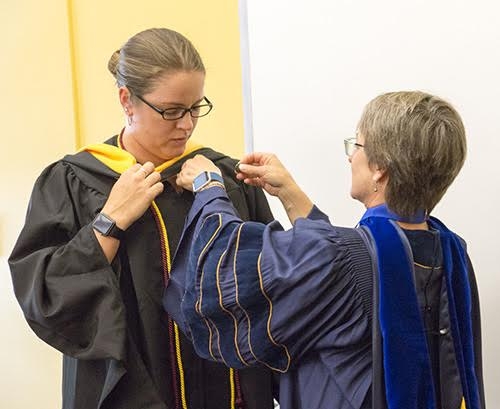You have /5 articles left.
Sign up for a free account or log in.

Jody Donovan (right) with one of her online graduate students who she met in person for the first time when the learner graduated.
Colorado State
Online learning, said Lynda Randall, a professor of secondary education at California State University at Fullerton, can be “a lonely enterprise if it’s just a repository of articles.”
Yet many traditional online courses, she said, are “based solely on text discussions.… That really results in an anemic learning experience.”
Randall takes a different approach. She engages her online students in discussions -- with each other -- about themselves and about the coursework via video and video conferencing in an effort to create an online community in a class whose participants are unlikely ever to meet each other in person.
Randall isn’t alone. As online courses become routine offerings at institutions across the world, more professors who teach them are embracing the notion that “social presence,” a concept promoted by the researchers D. Randy Garrison, Terry Anderson and Walter Archer in the early 2000s, is critical to the success of the online learner.
Together with cognitive presence and teaching presence, social presence occurs when students can connect on a human and emotional level. This is more likely to occur, the researchers concluded, when students can see and hear each other than when they simply read text-based messages.
Michelle Pacansky-Brock, innovations lead at California State University's Channel Islands campus, calls this approach “humanizing learning.” On her website, she explained: “In our digital age of knowledge abundance, an educator's value is no longer derived through the delivery of content. Rather, our new focus is on designing human-centered learning experiences.”
Instructors who aim to create a sense of community in their online courses advise others to:
Let students get to know you. Humanizing a course, Pacansky-Brock said in an interview with Inside Digital Learning, begins with humanizing the instructor.
“It’s important for instructors to present themselves as a real person, and also design a course that involves opportunities for students to do the same thing,” said Pacansky-Brock, author of Best Practices for Teaching With Emerging Technologies.
That does not involve a single formula, she said: “Everybody does this differently. Some instructors get really goofy and can be playful and really fun in videos.” She is more reserved, she said, but still lets students get to know her interests and personality.
So does Jody Donovan, an assistant professor in Colorado State University’s School of Education and co-coordinator of its graduate program in student affairs in higher education.
“I share who I am and all of my identities,” she said. “It’s not just about my credentials as a faculty member. I’m a white woman. I have an invisible disability. I talk about the pieces of who I am and how that informs how I show up in the classroom. Then I ask students to introduce themselves in the same framework.”
Encourage students to reveal their non-academic lives. For a unit on Jean Piaget's four stages of cognitive development in Randall’s class on adolescence, the professor assigned her students to create a three- to five-minute presentation that included a demonstration of one of the stages. A student with two small children at home videotaped them as he tested one of the concepts.
“Very often in a [video] web conference, we’ll have a child sitting on a parent’s lap and we get to say ‘hello,’” Randall said. “We often meet children and pets. We take an interest in getting to know each other.”
When Donovan’s children were in college, she conducted video interviews with them that tracked their development—and she shares her experiment with her classes. Likewise, she encourages her students to observe their kids and share those results with classmates.
Incorporate video. That wouldn’t happen, of course, if classmates could not see each other. So Randall provides assignments that use video and other visuals and incorporates it into her lectures.
She uses PowerPoint presentations for online lectures so students “have the same benefit they would have if they were able to be in the classroom. They can also play it back and rewind and play it as many times as they want,” she said.
In addition, Randall regularly records her feedback on student assignments rather than delivering written notes.
Meet in real time. It’s not always possible, especially if students have jobs or live abroad, but Randall schedules synchronous meetings with students so they can talk to each other in real time. During those sessions, she said, “our students find they have a lot in common.”
Randall organizes five synchronous sessions on the same topic, all at different times of the day and week so everyone can schedule one.
Work in small groups. “It just gets too unwieldy when students are in large groups,” Donovan said. So she breaks her classes into groups of eight or fewer for discussions, group projects, peer reviews and other collaborations.
“They don’t feel the size of the class,” she said. “They get very connected with the students in their group.” In a class of 50, she added, students “only feel like they’re in a class of 10.”
In fact, she said, some of her students -- even those who live far from Fort Collins, Colo. -- have gotten together to meet in person. Some have taken their families to Fort Collins for vacations and stayed at their classmates’ homes. When one traveled to Colorado to defend her graduate portfolio in person, several classmates flew in to meet her and hear her defense, Donovan said.
Require constant interaction. Group projects, required participation in discussions and collaborative writing assignments “force them to engage with one another outside the classroom as well as in the classroom,” Donovan said.
She recalled three students working on a group project a few years ago. One member was a recruiter for a Japanese university; another advised students taking classes in Hong Kong; and a third worked at an all-girls boarding high school in the U.S. “They taught each other,” Donovan said. “They brought their own contexts and broadened the world for one another.”
Rise to the challenge. Building community in an online classroom takes time, noted Donovan, and that downside can discourage professors from trying.
For one thing, she said, many instructors do not do community building in their face-to-face classrooms, so trying that online might be new and require planning and experimentation.
In addition, depending on the demographic makeup of the class each semester, professors attempting to build classroom communities face the challenge of mediating disputes that rise from cultural and demographic differences among the students.
“If students are fully engaged, this is a lot easier,” she said. “But if there are students who come and go and are fairly invisible in the [online classroom] community, it’s more challenging to get to know the students. It takes a little more time.”
Pacansky-Brock said this kind of engagement is what students will remember when the course is finished. “When you reflect on your college classes, the ones that you remember the most were the ones that involved relationships,” she said. “They were the ones that made you feel connected in some way to the instructor and you felt like you were part of a group in the class.
“That’s exactly what is important in an online class.”




